Investigating the relationships between asean stock markets: an approach using the granger causality test of time-Varying information efficiency
The information efficiency and the relationships between ASEAN stock markets are two of
the issues that are of great research interest. However, these two issues were often
investigated separately in previous studies. Therefore, this paper combines these two issues
in the same analysis. Data on the daily closing index of six ASEAN stock markets, including
Indonesia, Malaysia, the Philippines, Singapore, Thailand, and Vietnam are used to
calculate Shannon entropy to measure the stock market information efficiency. In addition,
this paper conducts the Granger causality test to reveal the relationships between the ASEAN
stock markets. The results show that all six stock markets are not in the state of information
efficiency, which means the stock indices, stock returns, and volatility are not purely random,
but patterned. In addition, the Granger test results show that the ASEAN stock markets are
logically correlated. The two markets that are more integrated than the others are Indonesia
and Malaysia. Vietnam participates in regional economics in a passive way, while the
Philippines is more proactive. The Singapore stock market is also less integrated with the
other ASEAN markets, although it is a mature stock market that outperforms the rest
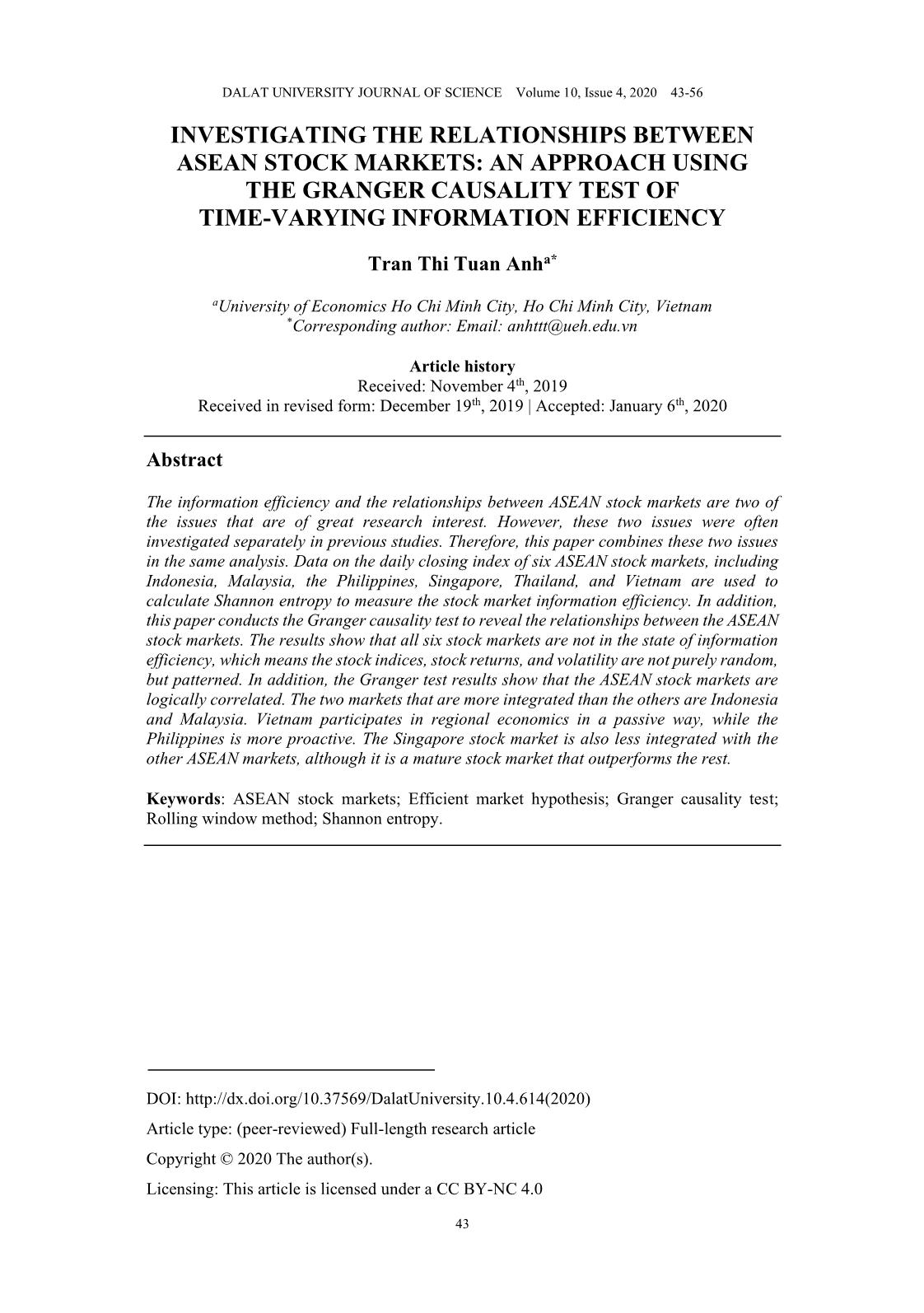
Trang 1
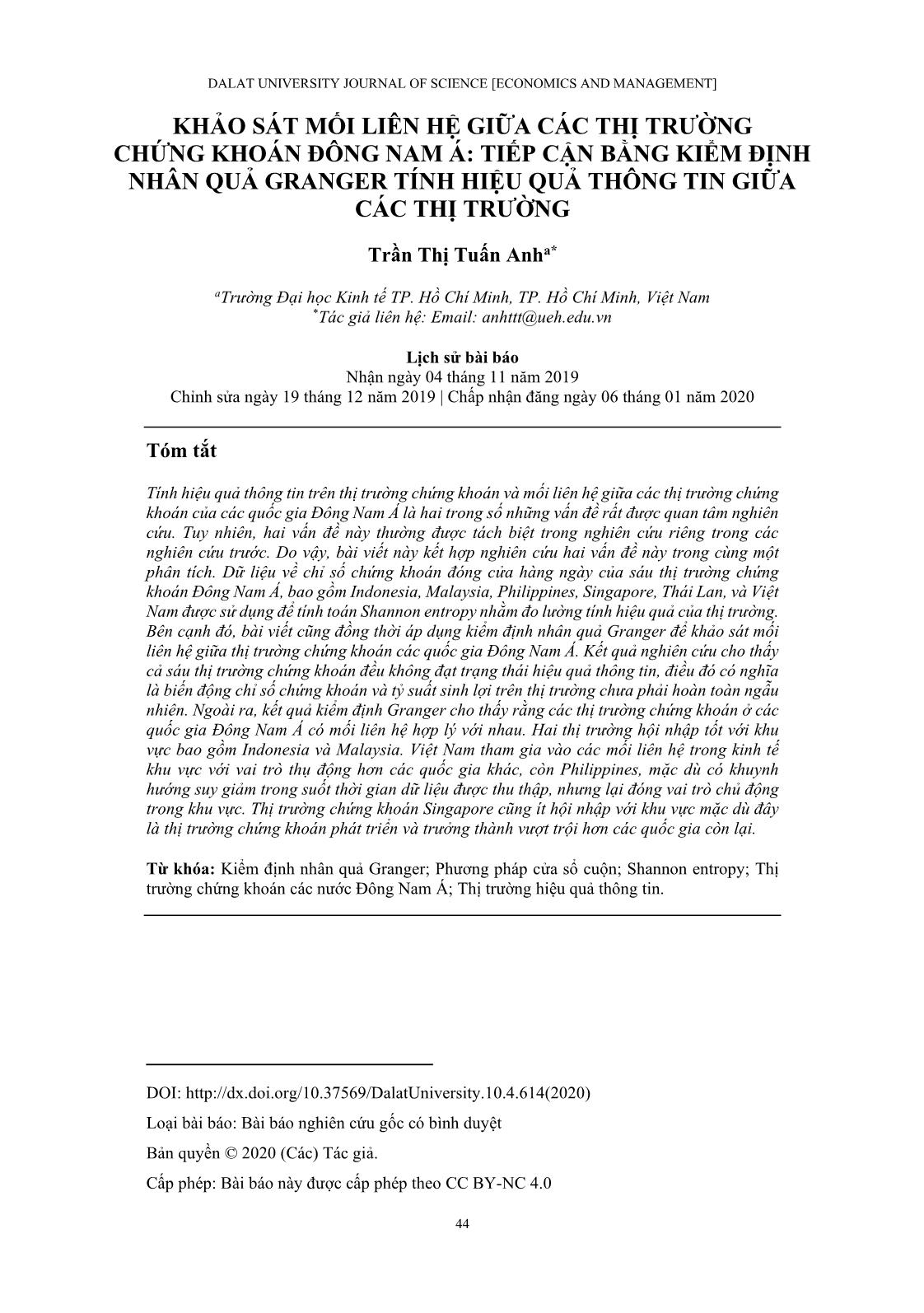
Trang 2
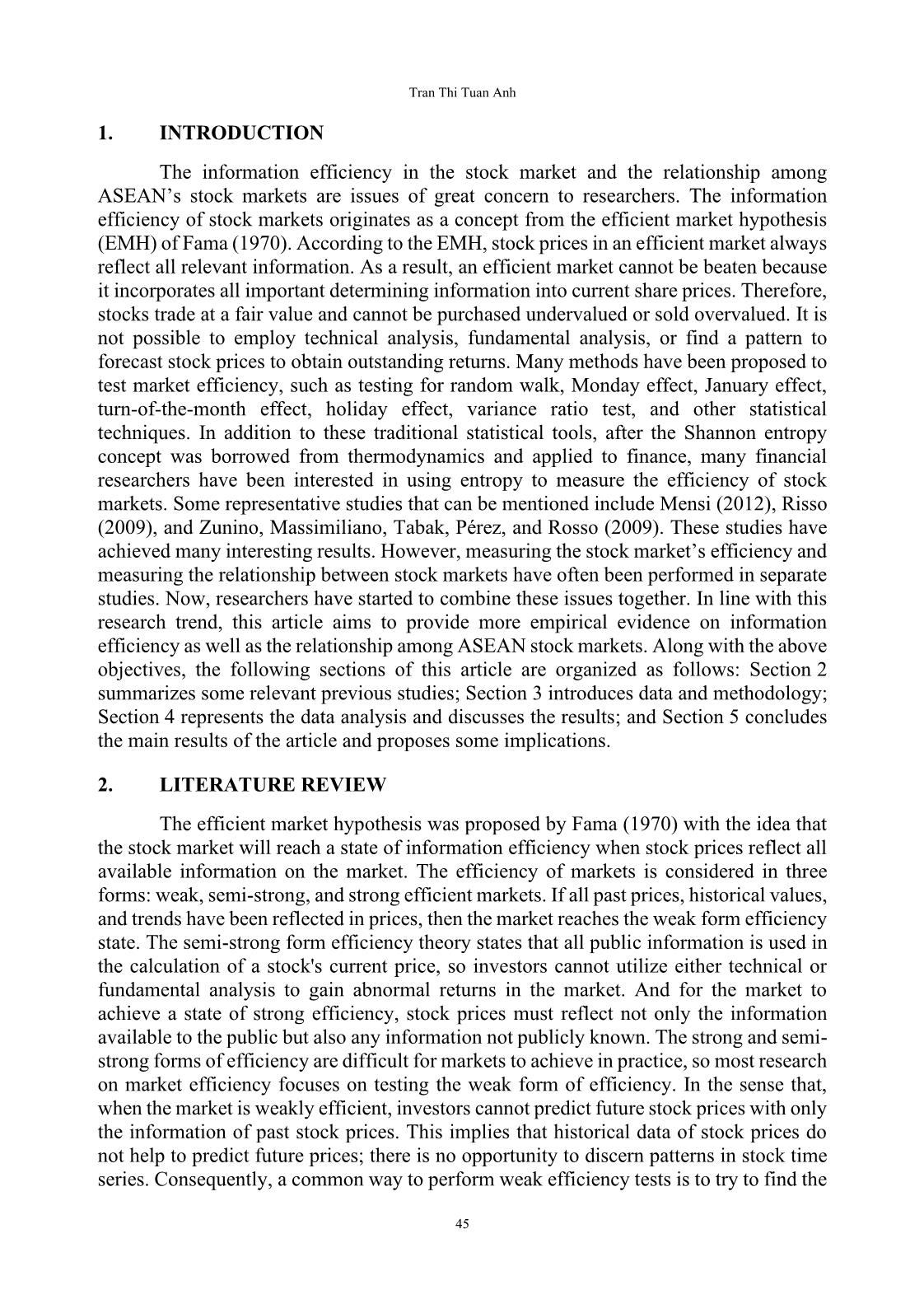
Trang 3
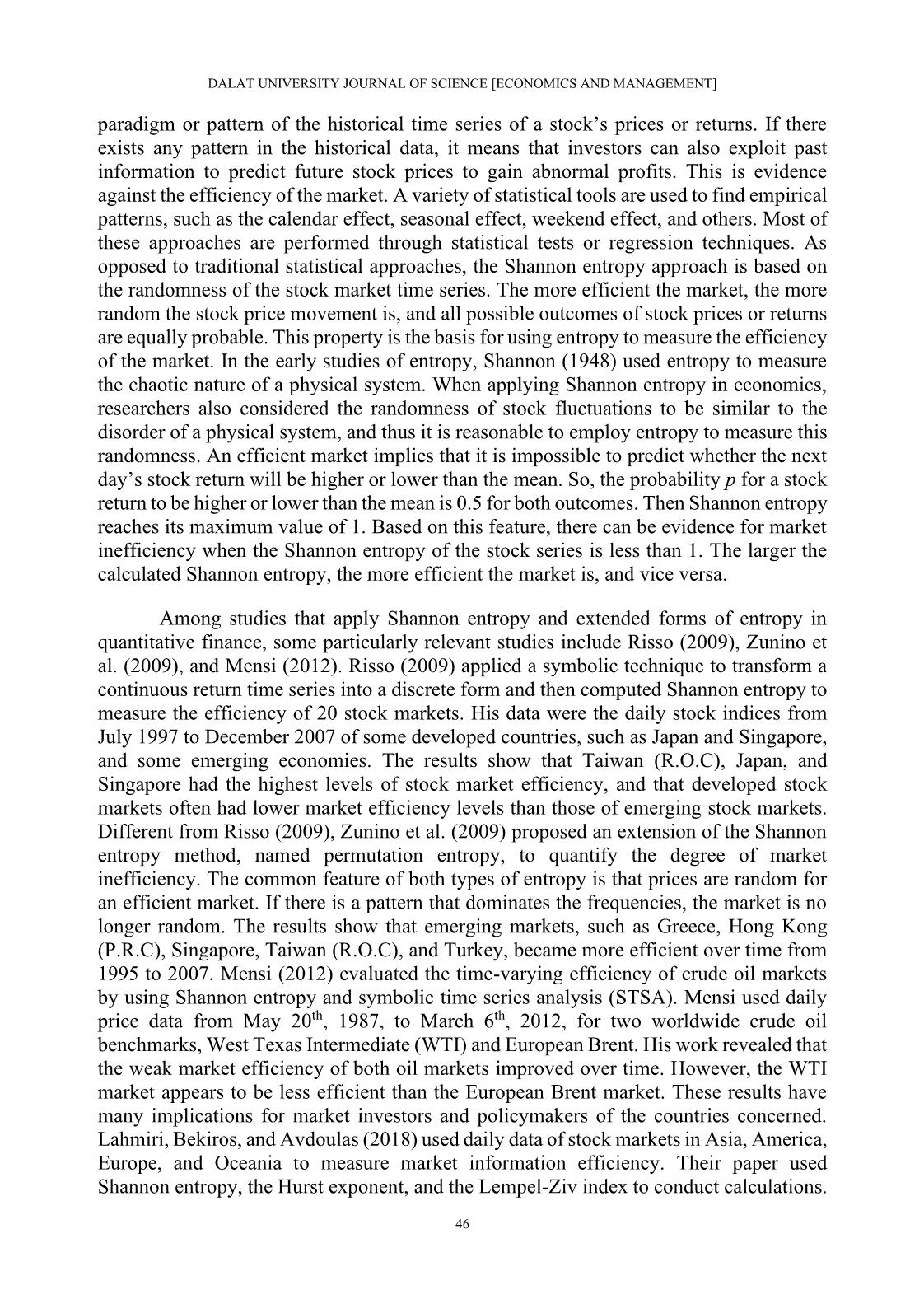
Trang 4
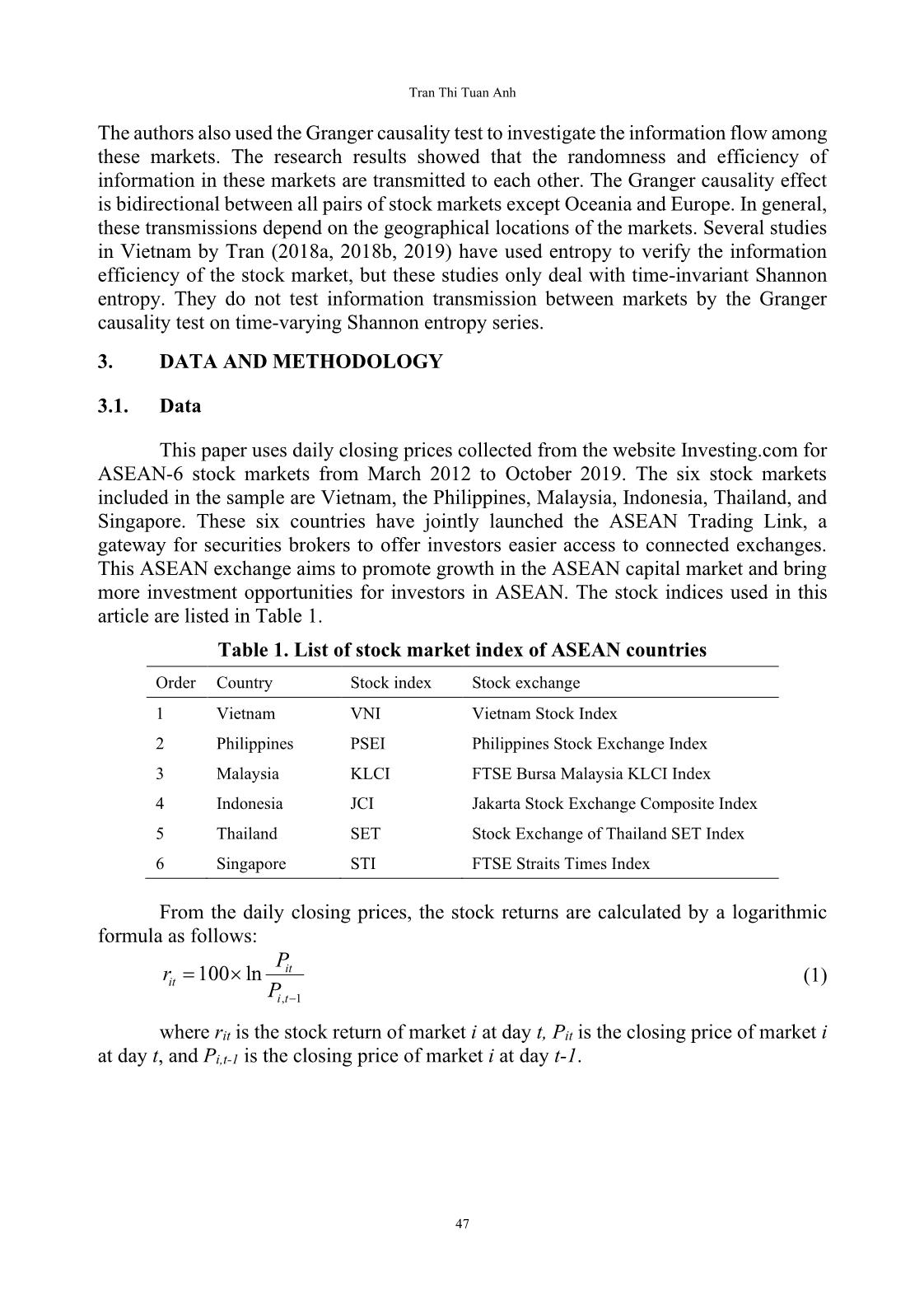
Trang 5
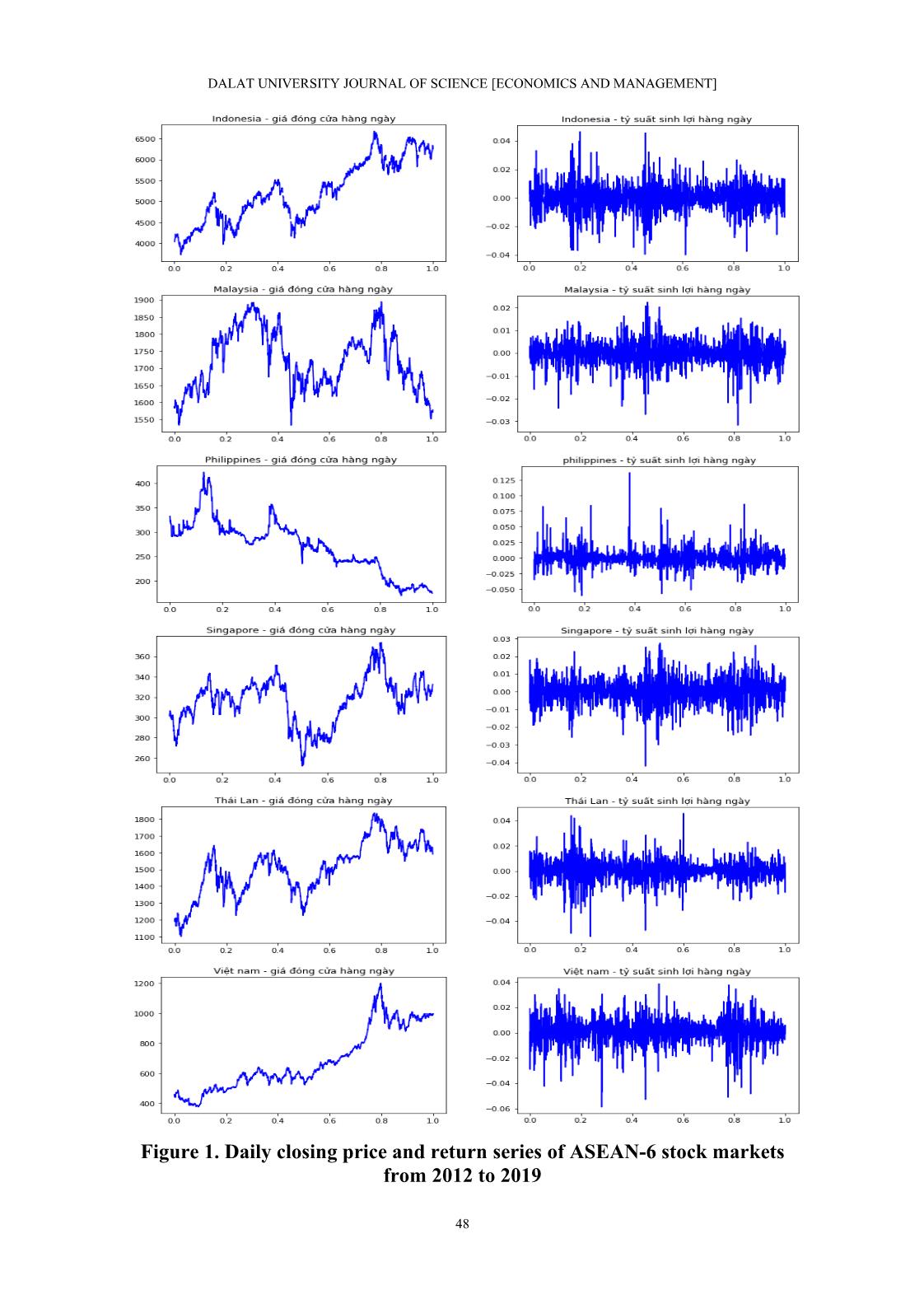
Trang 6
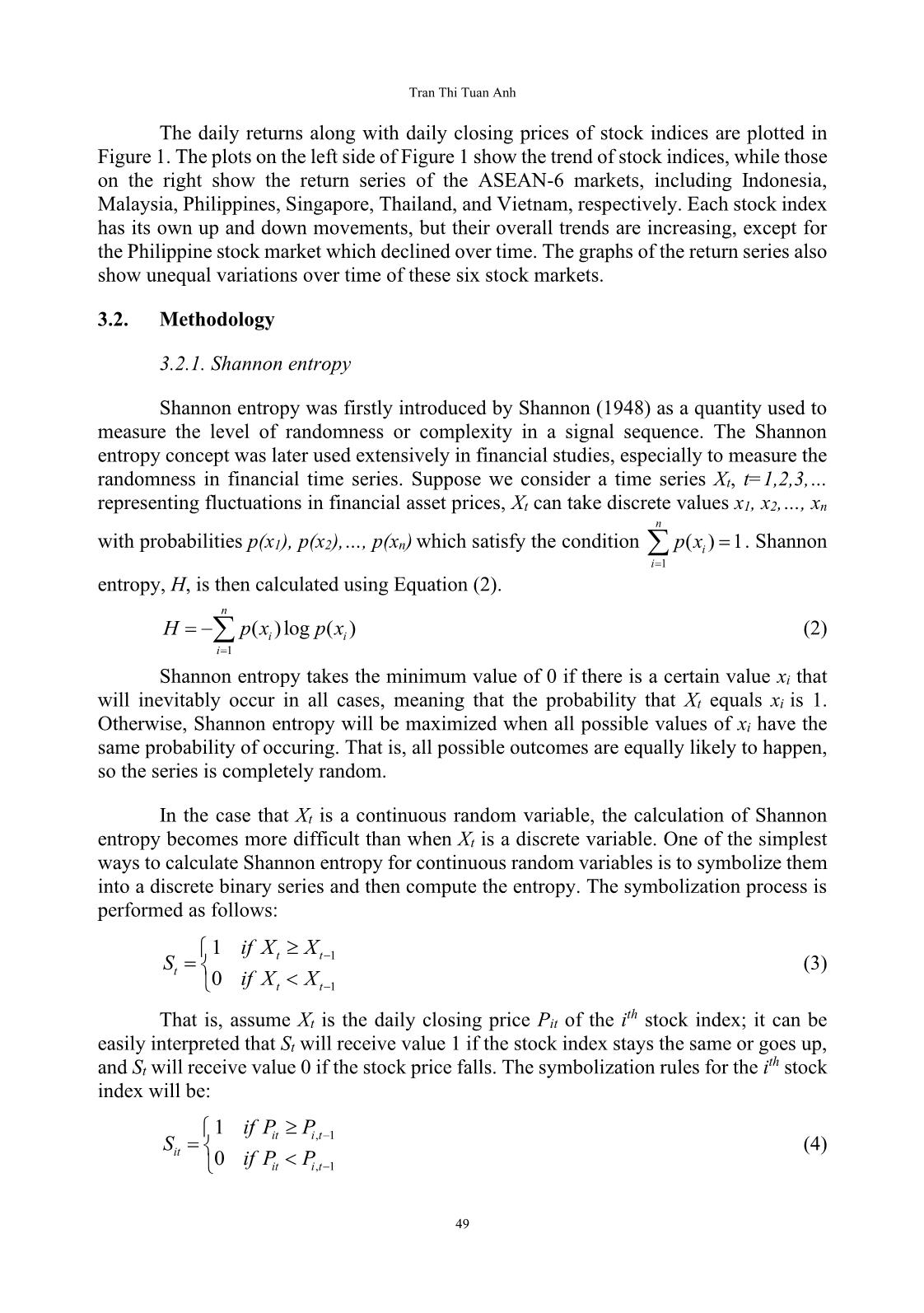
Trang 7
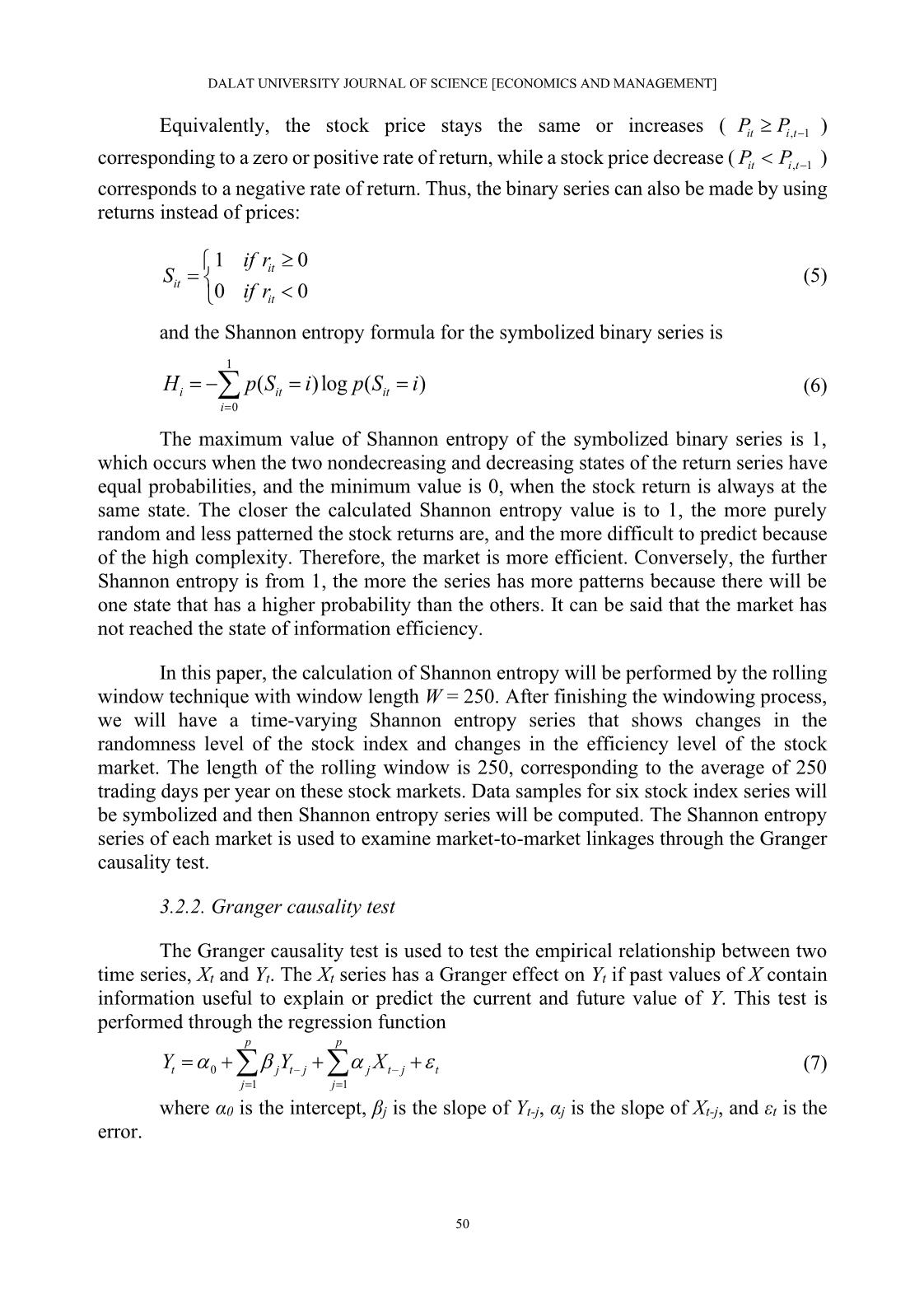
Trang 8
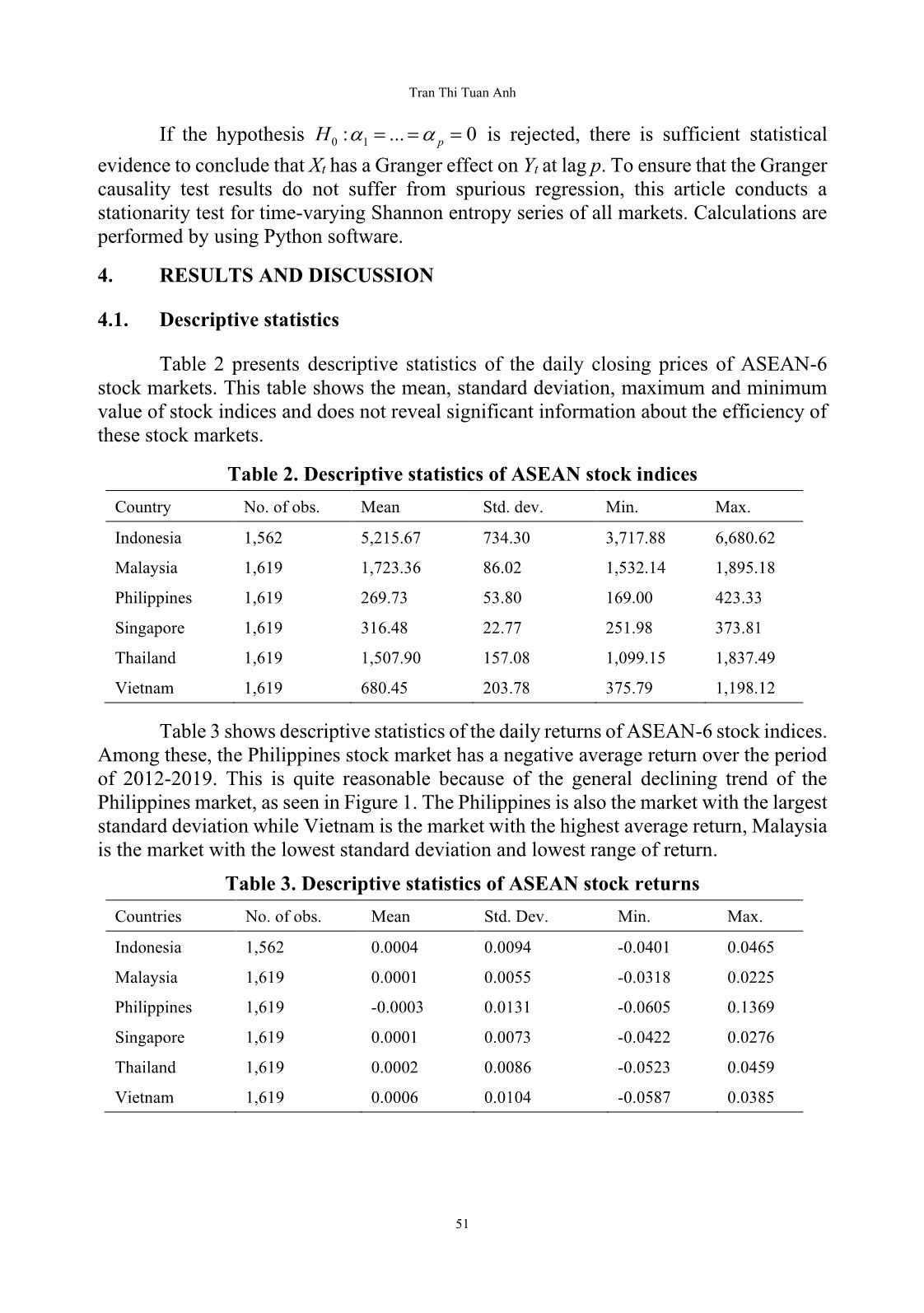
Trang 9
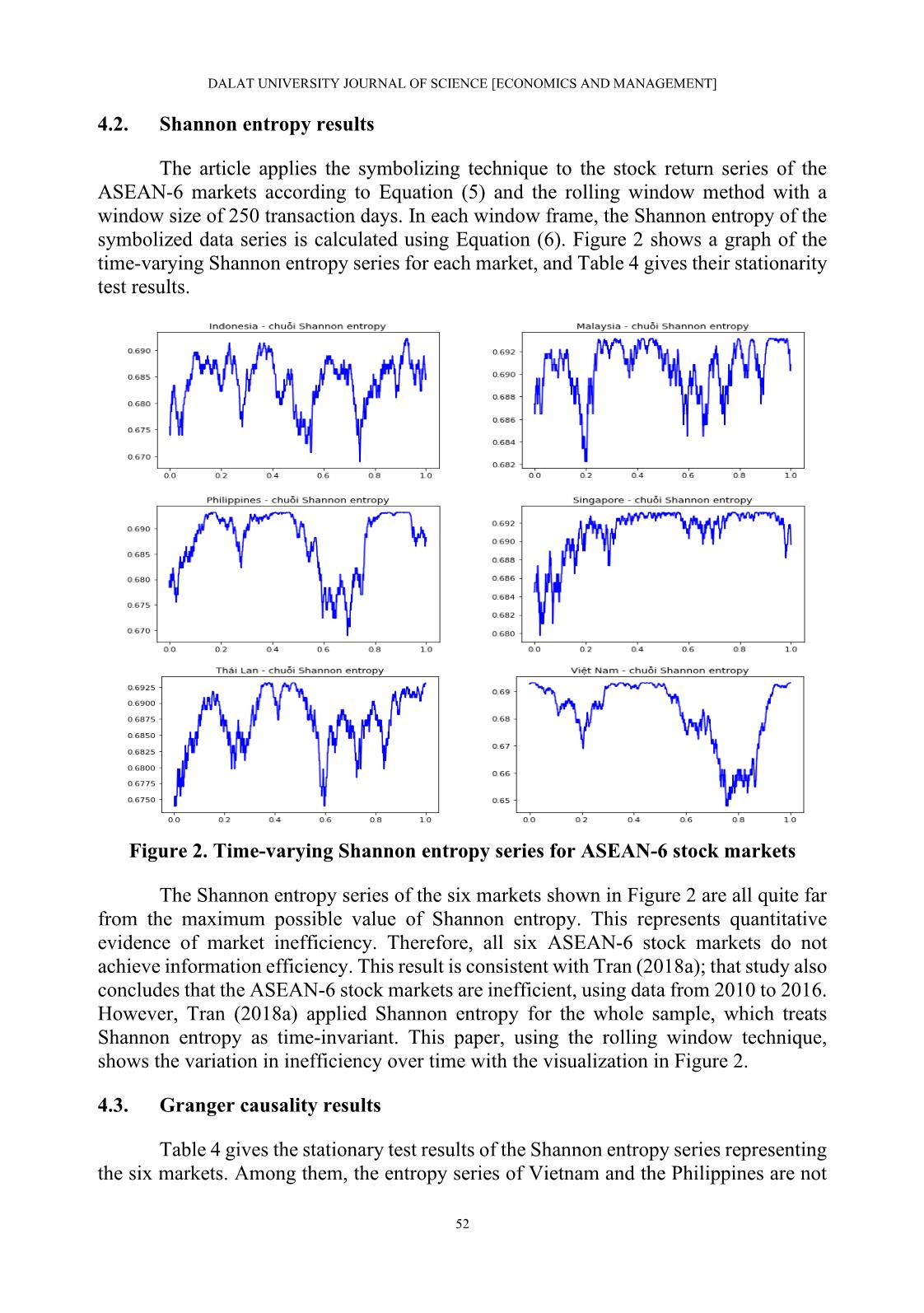
Trang 10
Tải về để xem bản đầy đủ
Tóm tắt nội dung tài liệu: Investigating the relationships between asean stock markets: an approach using the granger causality test of time-Varying information efficiency

DALAT UNIVERSITY JOURNAL OF SCIENCE Volume 10, Issue 4, 2020 43-56 43 INVESTIGATING THE RELATIONSHIPS BETWEEN ASEAN STOCK MARKETS: AN APPROACH USING THE GRANGER CAUSALITY TEST OF TIME-VARYING INFORMATION EFFICIENCY Tran Thi Tuan Anha* aUniversity of Economics Ho Chi Minh City, Ho Chi Minh City, Vietnam *Corresponding author: Email: anhttt@ueh.edu.vn Article history Received: November 4th, 2019 Received in revised form: December 19th, 2019 | Accepted: January 6th, 2020 Abstract The information efficiency and the relationships between ASEAN stock markets are two of the issues that are of great research interest. However, these two issues were often investigated separately in previous studies. Therefore, this paper combines these two issues in the same analysis. Data on the daily closing index of six ASEAN stock markets, including Indonesia, Malaysia, the Philippines, Singapore, Thailand, and Vietnam are used to calculate Shannon entropy to measure the stock market information efficiency. In addition, this paper conducts the Granger causality test to reveal the relationships between the ASEAN stock markets. The results show that all six stock markets are not in the state of information efficiency, which means the stock indices, stock returns, and volatility are not purely random, but patterned. In addition, the Granger test results show that the ASEAN stock markets are logically correlated. The two markets that are more integrated than the others are Indonesia and Malaysia. Vietnam participates in regional economics in a passive way, while the Philippines is more proactive. The Singapore stock market is also less integrated with the other ASEAN markets, although it is a mature stock market that outperforms the rest. Keywords: ASEAN stock markets; Efficient market hypothesis; Granger causality test; Rolling window method; Shannon entropy. DOI: Article type: (peer-reviewed) Full-length research article Copyright © 2020 The author(s). Licensing: This article is licensed under a CC BY-NC 4.0 DALAT UNIVERSITY JOURNAL OF SCIENCE [ECONOMICS AND MANAGEMENT] 44 KHẢO SÁT MỐI LIÊN HỆ GIỮA CÁC THỊ TRƯỜNG CHỨNG KHOÁN ĐÔNG NAM Á: TIẾP CẬN BẰNG KIỂM ĐỊNH NHÂN QUẢ GRANGER TÍNH HIỆU QUẢ THÔNG TIN GIỮA CÁC THỊ TRƯỜNG Trần Thị Tuấn Anha* aTrường Đại học Kinh tế TP. Hồ Chí Minh, TP. Hồ Chí Minh, Việt Nam *Tác giả liên hệ: Email: anhttt@ueh.edu.vn Lịch sử bài báo Nhận ngày 04 tháng 11 năm 2019 Chỉnh sửa ngày 19 tháng 12 năm 2019 | Chấp nhận đăng ngày 06 tháng 01 năm 2020 Tóm tắt Tính hiệu quả thông tin trên thị trường chứng khoán và mối liên hệ giữa các thị trường chứng khoán của các quốc gia Đông Nam Á là hai trong số những vấn đề rất được quan tâm nghiên cứu. Tuy nhiên, hai vấn đề này thường được tách biệt trong nghiên cứu riêng trong các nghiên cứu trước. Do vậy, bài viết này kết hợp nghiên cứu hai vấn đề này trong cùng một phân tích. Dữ liệu về chỉ số chứng khoán đóng cửa hàng ngày của sáu thị trường chứng khoán Đông Nam Á, bao gồm Indonesia, Malaysia, Philippines, Singapore, Thái Lan, và Việt Nam được sử dụng để tính toán Shannon entropy nhằm đo lường tính hiệu quả của thị trường. Bên cạnh đó, bài viết cũng đồng thời áp dụng kiểm định nhân quả Granger để khảo sát mối liên hệ giữa thị trường chứng khoán các quốc gia Đông Nam Á. Kết quả nghiên cứu cho thấy cả sáu thị trường chứng khoán đều không đạt trạng thái hiệu quả thông tin, điều đó có nghĩa là biến động chỉ số chứng khoán và tỷ suất sinh lợi trên thị trường chưa phải hoàn toàn ngẫu nhiên. Ngoài ra, kết quả kiểm định Granger cho thấy rằng các thị trường chứng khoán ở các quốc gia Đông Nam Á có mối liên hệ hợp lý với nhau. Hai thị trường hội nhập tốt với khu vực bao gồm Indonesia và Malaysia. Việt Nam tham gia vào các mối liên hệ trong kinh tế khu vực với vai trò thụ động hơn các quốc gia khác, còn Philippines, mặc dù có khuynh hướng suy giảm trong suốt thời gian dữ liệu được thu thập, nhưng lại đóng vai trò chủ động trong khu vực. Thị trường chứng khoán Singapore cũng ít hội nhập với khu vực mặc dù đây là thị trường chứng khoán phát triển và trưởng thành vượt trội hơn các quốc gia còn lại. Từ khóa: Kiểm định nhân quả Granger; Phương pháp cửa sổ cuộn; Shannon entropy; Thị trường chứng khoán các nước Đông Nam Á; Thị trường hiệu quả thông tin. DOI: Loại bài báo: Bài báo nghiên cứu gốc có bình duyệt Bản quyền © 2020 (Các) Tác giả. Cấp phép: Bài báo này được cấp phép theo CC BY-NC 4.0 Tran Thi Tuan Anh 45 1. INTRODUCTION The information efficiency in the stock market and the relationship among ASEAN’s stock markets are issues of great concern to researchers. The information efficiency of stock markets originates as a concept from the efficient market hypothesis (EMH) of Fama (1970). According to the EMH, stock prices in an efficient market always reflect all relevant information. As a result, an efficient market cannot be beaten because it incorporates all important determining information into current share prices. Therefore, stocks trade at a fair value and cannot be purchased undervalued or sold overvalued. It is not possible to employ technical analysis, fundamental analysis, or find a pattern to forecast stock prices to obtain outstanding returns. Many methods have been proposed to test market efficiency, such as testing for random walk, Monday effect, January effect, turn-of-the-month effect, holiday effect, variance ratio test, and other statistical techniques. In addition to these traditional statistical tools, after the Shannon entropy concept was borrowed from thermodynamics and applied to finance, many financial researchers have been interested in using entropy to measure the efficiency of stock markets. Some representative studies that can be mentioned include Mensi (2012), Risso (2009), and Zunino, Massimiliano, Tabak, Pérez, and Rosso (2009). These studies have achiev ... ows changes in the randomness level of the stock index and changes in the efficiency level of the stock market. The length of the rolling window is 250, corresponding to the average of 250 trading days per year on these stock markets. Data samples for six stock index series will be symbolized and then Shannon entropy series will be computed. The Shannon entropy series of each market is used to examine market-to-market linkages through the Granger causality test. 3.2.2. Granger causality test The Granger causality test is used to test the empirical relationship between two time series, Xt and Yt. The Xt series has a Granger effect on Yt if past values of X contain information useful to explain or predict the current and future value of Y. This test is performed through the regression function 0 1 1 p p t j t j j t j t j j Y Y X − − = = = + + + (7) where α0 is the intercept, βj is the slope of Yt-j, αj is the slope of Xt-j, and εt is the error. Tran Thi Tuan Anh 51 If the hypothesis 0 1: ... 0pH = = = is rejected, there is sufficient statistical evidence to conclude that Xt has a Granger effect on Yt at lag p. To ensure that the Granger causality test results do not suffer from spurious regression, this article conducts a stationarity test for time-varying Shannon entropy series of all markets. Calculations are performed by using Python software. 4. RESULTS AND DISCUSSION 4.1. Descriptive statistics Table 2 presents descriptive statistics of the daily closing prices of ASEAN-6 stock markets. This table shows the mean, standard deviation, maximum and minimum value of stock indices and does not reveal significant information about the efficiency of these stock markets. Table 2. Descriptive statistics of ASEAN stock indices Country No. of obs. Mean Std. dev. Min. Max. Indonesia 1,562 5,215.67 734.30 3,717.88 6,680.62 Malaysia 1,619 1,723.36 86.02 1,532.14 1,895.18 Philippines 1,619 269.73 53.80 169.00 423.33 Singapore 1,619 316.48 22.77 251.98 373.81 Thailand 1,619 1,507.90 157.08 1,099.15 1,837.49 Vietnam 1,619 680.45 203.78 375.79 1,198.12 Table 3 shows descriptive statistics of the daily returns of ASEAN-6 stock indices. Among these, the Philippines stock market has a negative average return over the period of 2012-2019. This is quite reasonable because of the general declining trend of the Philippines market, as seen in Figure 1. The Philippines is also the market with the largest standard deviation while Vietnam is the market with the highest average return, Malaysia is the market with the lowest standard deviation and lowest range of return. Table 3. Descriptive statistics of ASEAN stock returns Countries No. of obs. Mean Std. Dev. Min. Max. Indonesia 1,562 0.0004 0.0094 -0.0401 0.0465 Malaysia 1,619 0.0001 0.0055 -0.0318 0.0225 Philippines 1,619 -0.0003 0.0131 -0.0605 0.1369 Singapore 1,619 0.0001 0.0073 -0.0422 0.0276 Thailand 1,619 0.0002 0.0086 -0.0523 0.0459 Vietnam 1,619 0.0006 0.0104 -0.0587 0.0385 DALAT UNIVERSITY JOURNAL OF SCIENCE [ECONOMICS AND MANAGEMENT] 52 4.2. Shannon entropy results The article applies the symbolizing technique to the stock return series of the ASEAN-6 markets according to Equation (5) and the rolling window method with a window size of 250 transaction days. In each window frame, the Shannon entropy of the symbolized data series is calculated using Equation (6). Figure 2 shows a graph of the time-varying Shannon entropy series for each market, and Table 4 gives their stationarity test results. Figure 2. Time-varying Shannon entropy series for ASEAN-6 stock markets The Shannon entropy series of the six markets shown in Figure 2 are all quite far from the maximum possible value of Shannon entropy. This represents quantitative evidence of market inefficiency. Therefore, all six ASEAN-6 stock markets do not achieve information efficiency. This result is consistent with Tran (2018a); that study also concludes that the ASEAN-6 stock markets are inefficient, using data from 2010 to 2016. However, Tran (2018a) applied Shannon entropy for the whole sample, which treats Shannon entropy as time-invariant. This paper, using the rolling window technique, shows the variation in inefficiency over time with the visualization in Figure 2. 4.3. Granger causality results Table 4 gives the stationary test results of the Shannon entropy series representing the six markets. Among them, the entropy series of Vietnam and the Philippines are not Tran Thi Tuan Anh 53 stationary at the level but stationary at the first difference. To avoid spurious results for the Granger causality test, the Shannon entropy series of Vietnam and the Philippines were taken at the first difference. The Shannon entropy series for Indonesia, Malaysia, Singapore, and Thailand were considered at the level. Table 4. Unit root test for time-varying Shannon entropy series of ASEAN-6 stock markets Country Augmented Dickey-Fuller Test Level First difference Indonesia -3.4810*** Malaysia -3.1407** Philippines -2.1837 -7.4275*** Singapore -3.1660 Thailand -3.3024** Vietnam -1.4110 -17.2040*** Notes: *, **, *** correspond to significance levels of 10%, 5%, and 1%, respectively. Table 5 shows the results of the Granger causality test of the Shannon entropy series among the ASEAN-6 stock markets. The series included in the Granger causality test are all stationary after taking the first difference for entropy series of Vietnam and the Philippines. However, the difference symbols are not shown in Table 5 of the Granger causality test. Table 5 shows the results of the Granger causality test between the Shannon entropy series ASEAN-6 stock markets. Since the Granger causality test results may depend on the chosen lag, we perform the Granger causality test with lags from 1 to 5 to account for weekly seasonal trends in the data. The stock markets are not trading on weekends, so the lag of 5 represents the one-week cycle in the stock market. The results are summarized in Table 5 and shown in Figure 3, where the statistically significant Granger relationships are represented by arrows connecting the countries' names. Figure 3. Relationships among ASEAN-6 stock markets by Granger causality test Indonesia Vietnam Thailand Singapore Philippines Malaysia DALAT UNIVERSITY JOURNAL OF SCIENCE [ECONOMICS AND MANAGEMENT] 54 Table 5. Granger causality test–sorted by causal market Causal market Response market F-statistic Lag 1 Lag 2 Lag 3 Lag 4 Lag 5 Indonesia => Malaysia 0.130 1.510 3.610** 2.800** 2.340** Indonesia => Philippines 0.690 0.440 0.650 1.300 1.170 Indonesia => Singapore 0.330 1.050 1.220 1.060 1.010 Indonesia => Thailand 1.010 2.730* 2.940** 2.410** 2.050* Indonesia => Vietnam 3.610* 2.150 3.390** 4.460*** 3.760*** Malaysia => Indonesia 0.940 2.160 3.180** 4.530*** 0.954*** Malaysia => Philippines 0.000 0.330 0.390 0.290 0.170 Malaysia => Singapore 0.000 0.780 0.660 0.560 0.870 Malaysia => Thailand 3.470* 1.850 1.580 1.250 0.980 Malaysia => Vietnam 6.960*** 5.040*** 5.910*** 5.280*** 4.220*** Philippines => Indonesia 2.490 1.160 1.930 1.380 3.700*** Philippines => Malaysia 0.100 1.430 1.480 1.320 2.690** Philippines => Singapore 4.180** 2.330* 1.520 1.120 1.870* Philippines => Thailand 0.290 2.890* 2.720* 2.590** 2.620** Philippines => Vietnam 0.910 0.710 0.860 0.760 1.800 Singapore => Indonesia 0.100 0.370 0.370 1.510 1.350 Singapore => Malaysia 0.080 0.310 0.550 0.540 0.440 Singapore => Philippines 1.860 2.000 2.200* 1.840 3.030** Singapore => Thailand 0.150 0.600 0.770 0.570 0.710 Singapore => Vietnam 2.220 1.250 0.810 0.610 0.500 Thailand => Indonesia 0.790 0.720 0.590 0.700 0.680 Thailand => Malaysia 0.830 1.200 0.970 0.640 0.700 Thailand => Philippines 0.150 1.150 0.640 0.440 0.300 Thailand => Singapore 1.200 0.620 0.490 0.450 0.370 Thailand => Vietnam 2.500 2.030 1.780 5.210*** 4.230*** Vietnam => Indonesia 0.050 1.510 1.160 0.990 1.190 Vietnam => Malaysia 0.410 0.240 0.300 0.280 0.530 Vietnam => Philippines 0.000 0.890 1.280 1.830 1.450 Vietnam => Singapore 2.880* 2.350* 1.960 1.640 1.350 Vietnam => Thailand 0.090 0.710 0.450 0.520 1.060 Notes: *, **, *** correspond to significance levels of 10%, 5%, and 1%, respectively. It can be seen from Figure 3 that each of these six markets is linked to at least three other markets and that there is no isolated market. There are some markets which Tran Thi Tuan Anh 55 are more integrated than the others. The most well-integrated markets, as shown in Figure 3, are Indonesia and Malaysia, with connections occurring with most other countries, except Singapore. The results also show that the role of Vietnam is very different from that of the Philippines in these relationships. Vietnam suffers impacts from other markets but has less impact on them; whereas the statistical evidence shows that the Philippines has a useful role in providing information to predict stock market movements of many other countries. The results of this study are consistent with some previous studies on the stock market linkages of ASEAN countries. Jiang, Niea, and Monginsidi (2017), using the variational mode decomposition and copula methods, also show a close relationship between the Indonesian and Malaysian stock markets, as well as a weak relationship between Vietnam and other markets in the region. Similarly, another study by Gabriella, Suryanarayana, and Esady (2016) also found evidence of a strong short-term spillover effect among these ASEAN-6 countries. 5. CONCLUSION AND IMPLICATIONS This article uses data on daily closing prices of ASEAN-6 stock markets, including Indonesia, Malaysia, the Philippines, Singapore, Thailand, and Vietnam. The daily returns are also calculated and used to construct a symbolized series. The rolling window technique was applied in combination with the Shannon entropy for each market to compute the time-varying entropy series. The Shannon entropy series of all ASEAN-6 stock markets do not attain the maximum value of 1, so this is evidence for information inefficiencies in all six markets. This result also implies that the stock index and return fluctuations on these markets are not completely random. They have potential patterns inside the series. Investors can use fundamental analysis or technical analysis tools to discover opportunities for outstanding profit. In addition, the paper also applies the Granger causality test with many different lags on the Shannon entropy series to find statistical evidence of the relationships between the ASEAN-6 stock markets. The Granger causality test reveals whether it is possible to use information from past markets to predict current and future information for other markets. According to the Granger causality test results, the ASEAN-6 stock markets have significant relationships with each other. Indonesia and Malaysia are two markets that are particularly well-integrated with the other markets. Vietnam plays a passive role in the relationships with other ASEAN stock markets because Vietnam receives more information from other markets than it transfers to them. Another interesting finding is that Philippines plays an active role in the region, more than Vietnam and other countries, despite the overall decreasing trend during the study period. Singapore’s stock market is also less integrated with the region, possibly because the Singapore market is quite mature and developed, so it has more links with other developed stock markets around the world, such as the US, EU, China, and Japan than with ASEAN’s developing markets. REFERENCES Gabriella, L. G., Suryanarayana, R., & Esady, V. (2016). Financial integration in ASEAN-5. Economics and Finance in Indonesia, 62(1), 44-58. DALAT UNIVERSITY JOURNAL OF SCIENCE [ECONOMICS AND MANAGEMENT] 56 Jianga, Y., Niea, H., & Monginsidi, J. Y. (2017). Co-movement of ASEAN stock markets: New evidence from wavelet and VMD-based copula tests. Economic Modelling, 64, 384-398. Fama, E. F. (1970). Efficient capital markets: A review of theory and empirical work. The Journal of Finance, 25(2), 383-417. Lahmiri, S., Bekiros, S., & Avdoulas, C. (2018). Time-dependent complexity measurement of causality in international equity markets: A spatial approach. Chaos, Solitons, & Fractals, 116, 215-219. Mensi, W. (2012). Ranking efficiency for twenty-six emerging stock markets and financial crisis: Evidence from the Shannon entropy approach. International Journal of Management Science and Engineering Management, 7(1), 53-63. Risso, W. A. (2009). The informational efficiency: The emerging markets versus the developed markets. Applied Economics Letters, 16(5), 485-487. Shannon, C. E. (1948). A mathematical theory of communication. The Bell System Technical Journal, 27(3), 379-423. Tran, T. T. A. (2018a). Đo lường mức độ hiệu quả thông tin trên thị trường chứng khoán các nước Đông Nam Á bằng Shannon entropy. Tạp chí Kinh tế và Phát triển, (252), 22-29. Tran, T. T. A. (2018b). Đo lường tính hiệu quả của thị trường chứng khoán Việt Nam bằng Shannon entropy và mối liên hệ với khả năng sụt giảm của chỉ số thị trường. Tạp chí Công nghệ Ngân hàng, (151), 7-17. Tran, T. T. A. (2019). Đo lường độ phức tạp trong chuỗi thời gian của các cổ phiếu trong danh mục VN30: Tiếp cận bằng entropy hoán vị. Tạp chí Khoa học Đại học Mở TP. Hồ Chí Minh, 14(1), 18-28. Zunino, L., Massimiliano, Z., Tabak, B. M., Pérez, D. G., & Rosso, O. A. (2009). Forbidden patterns, permutation entropy, and stock market inefficiency. Physica A, 388, 2854-2864.
File đính kèm:
 investigating_the_relationships_between_asean_stock_markets.pdf
investigating_the_relationships_between_asean_stock_markets.pdf

